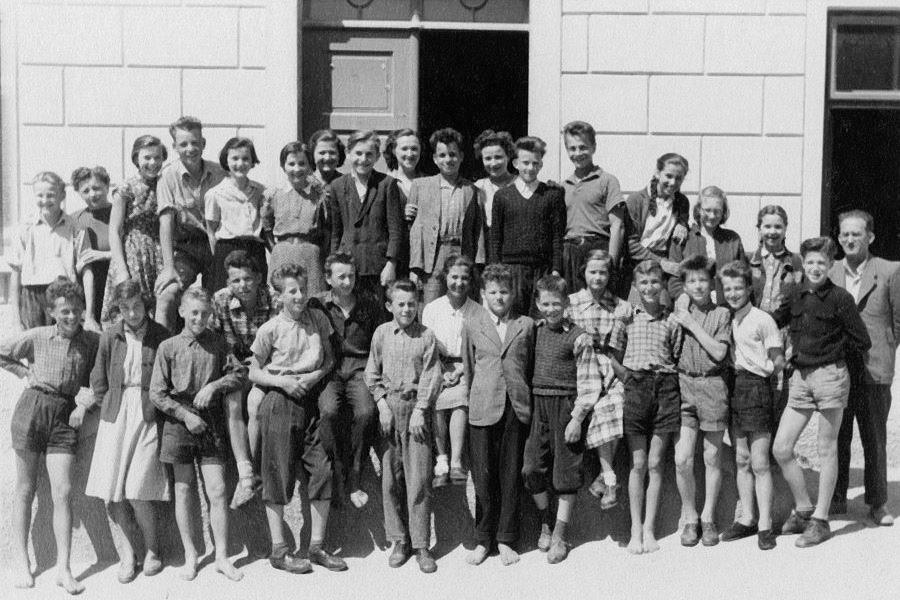
Slovenian Schools

Figure 1.--This photograph was taken in Cerknica, southwestern Slovenia, during Spring 1956.
It shows a 3rd year class at Lower Grammar School (Nižje Gimnazije). It is the 7th grade meaning mostly 12-13 year olds. At the time many pupils attending primary school and the lower secondary grades went to school barefoot. It was less common among teenagers. Slovenia, then part of Communist Yugoslavia, was the most prosperous part of the country. Unlike much of Western Europe, however, it was not keeping up with the economic progressuve of Western Europe.
|
|
We have no information on Slovenia education during the medieval era. Our information only comes from the 19th century during the Asustro-Hungarian Empire era. Public education was a relatively new phemomenon, unlike Prussian and the northern (Protestant) German states. The Austria Law on Primary School Education (1869) not only accelerated the cultural development in Austria, especially in rural areas, but also in the Crown lands including much of modern Slovenia. The primary schools established were coeducational schools and brought education opportunities into rural areas with the creation of many village schools. Secondary education continued to be limited to urban areas and mostly middle- and upper-class children--largely boys. The principal secondary school was as in Germany the gymnasium. The language of instruction was German. Soon after World War I and the establishment of Kingdom of the Southern Slavs/Yugoslavia (1918), the process of using the local languages began. In the case of Slovenia it meant the Slovenisation of the existing Austrian education system. This mean secondary education in Slovenian. In addition the Slovenian University was organized. The existing Austrian education system was not significantly changed except the language of instruction. It is no accident that Slovenia was the best educated and most literate part of Yugoslavia. Slovenia was the only part of Yugoslavia associated with Austria. (Croatia was associated with Hungary and Bosnia was only rcently annexed in 1908.) Strangely the first major educationl reform was the Yugoslav Educational Law (1958). This occurred well into the Communist era. The principal change was to shift student choice to aater point in the educational pricess. The Austriam imperial system offered a variety of choices only during the compulsory primary phase. The new Yugoslav system which was mandated for each of the states in the federation shifted differentiation from age 11 years to 15 year olds. It only increased eucational opportunities for most children. Yugoslav educators describe it as replacing a hard transition with a softer process whuch increased the nunber of children in the secondary schools. [Gabrič]
Sources
Gabrič, Alen. "The education system in Slovenia in the 20th century", DR, Vol. XVI (2000) 32-33.
Careful, clicking on these will exit you from the Boys' Historical Clothing web site, but several are highly recommended
Boys' Preparstory Schools: Apertures Press has published a 125-page hard cover book depicting every-day life at British preparatory schools. The book includes about 250 never before published black and white and color photographs illustrating school life during the 1980s. There are also many older photographs to illustrate a brief historical essay providing background information on these splendid little schools. Accompanying the photographs are poems, essays, and quips by the children Preparatory schools in Britain prepare elementary-age children for the country's elite public (private) secondary schools.
themselves describing their school experiences. Most of the photographs were taken in England and Scotland, but British preparatory schools in Italy, New Zealand, South Africa, and Ulster are also shown.
Apertures Press New Zealand E-book: Aperures Press has publish its New Zealand school E-books. T this will permit readers to follow our process by viewing draft pages and pages in progress as we create them. Besides giving readers the opportunity to follow progress on the book as it develops, it gives our Quiwi friends the opportunity to review and comment on the various pages--allowing HBC to incorporate a much wider range of ideas and experiences than would otherwise have been possible.
British Preparatory Schools: These photographic books depict life at British preparatory schools during the 1980s. The schools are English and Scottish. The pictures depict the chool life and uniforms worn at many different schools.
HBC-SU

Navigate HBC Chronolgy Pages
[Late 19th century]
[The 1930s]
[The 1940s]
[The 1930s]
[The 1940s]
[The 1950s]
[The 1960s]
[The 1970s]
[The 1980s]
Related Style Pages in the Boys' Historical Web Site
[Long pants suits]
[Knicker suits]
[Short pants suits]
[Socks]
[Eton suits]
[Jacket and trousers]
[Blazer]
[School sandals]
Navigate the HBC School Section
[Return to the Main European regional school page ]
[Return to the Main Slovenian page]
[Activities]
[Chronology]
[Clothing styles]
[Countries]
[Debate]
[Economics]
[Garment]
[Gender]
[Hair]
[History]
[Home trends]
[Literary characters]
[School types]
[Significance]
[Transport and travel
[Uniform regulations]
[Year level]
[Other topics]
[Images]
[Links]
[Registration]
[Tools]
[Return to the Historic Boys' School Home]
Created: 4:20 AM 2/1/2018
Last updated: 4:20 AM 2/1/2018




